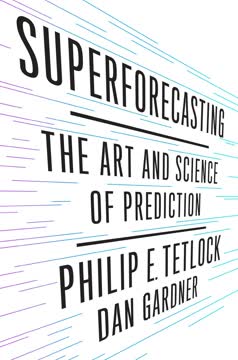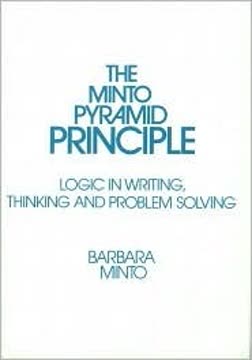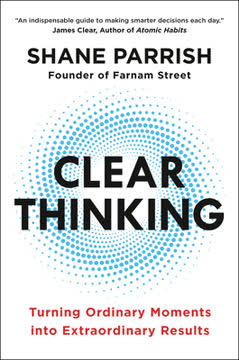Key Takeaways
1. Define the problem clearly and revisit it often
Good problem definition or framing can have a huge positive impact as we have shown in our examples.
Problem definition is critical. Take time to thoroughly understand the problem, its context, and the decision-maker's needs. Use a problem statement worksheet to capture key elements:
- Desired outcome
- Time frame
- Decision criteria and constraints
- Required accuracy
- Scale of aspirations
Be prepared to revise your problem statement as you learn more. Constantly iterate between your evolving understanding and new data or insights. This "porpoising" helps refine the problem and potential solutions.
Expand your perspective. Consider relaxing constraints or viewing the problem from different angles to unlock creative solutions. For example, the Avahan HIV project in India made a breakthrough by involving sex workers in developing solutions, rather than just focusing on traditional public health approaches.
2. Disaggregate complex problems into manageable parts
Any problem of real consequence is too complicated to solve without breaking it down into logical parts that help us understand the drivers or causes of the situation.
Use logic trees. Break down problems into components, factors, or hypotheses. Start with simple component trees and evolve to more sophisticated deductive or inductive logic trees as your understanding deepens. Aim for trees that are:
- Mutually Exclusive: Branches don't overlap
- Collectively Exhaustive: All relevant elements are included
Apply proven frameworks. For business problems, consider using:
- Price/Volume analysis
- Principal/Agent issues
- Assets/Options evaluation
- Collaborate/Compete strategies
For societal issues, explore frameworks like:
- Regulate/Incent approaches
- Equality/Liberty trade-offs
- Mitigate/Adapt strategies
- Supply/Demand analysis
3. Prioritize ruthlessly to focus on critical issues
Good problem solving is just as much about what you don't do as what you do, and good prioritization in problem solving makes solutions come faster and with less effort.
Use the 80/20 rule. Focus on the 20% of factors that drive 80% of the impact. Employ a 2x2 matrix to evaluate potential areas of focus:
- X-axis: Importance/Impact
- Y-axis: Ability to influence
Prioritize high-impact areas you can meaningfully affect. Be willing to prune off lower-priority branches of your logic tree to maintain focus on the critical path.
Conduct knock-out analyses. Quickly eliminate options or areas of inquiry that don't meet minimum thresholds. This prevents wasted effort on unproductive lines of investigation. For example, in a cost-reduction exercise, deprioritize units that can't meaningfully contribute to the overall target.
4. Create a structured workplan with clear hypotheses
Tools like Microsoft Project can be extremely helpful in workplanning. But they can also end up being like a beast that needs to be fed, generating enormous detail in workplanning that stretches out in time.
Develop hypothesis-driven workplans. For each analysis:
- State a clear hypothesis
- Specify the required output (e.g., chart type)
- Identify data sources
- Assign responsibility and deadlines
Use "chunky workplans" that focus on 2-3 weeks of critical analyses, coupled with lean project plans for overall milestones.
Employ one-day answers. Regularly summarize your current best understanding of the problem and potential solutions. Structure these in three parts:
- Situation: Current state of affairs
- Complication: Key tensions or changes
- Resolution: Best current idea of the solution
This practice clarifies thinking, identifies gaps, and provides a basis for productive team discussions.
5. Start analysis with simple heuristics before complex models
Start all analytic work with simple summary statistics and heuristics that help you see the size and shape of your problem levers.
Leverage powerful heuristics. Use rules of thumb to quickly gauge direction and magnitude:
- Occam's Razor: Favor the simplest explanation
- Order of magnitude: Estimate relative sizes
- Compound growth: Use the Rule of 72
- Expected value: Probability x Impact
- Break-even analysis: Fixed costs / (Price - Variable costs)
- Marginal analysis: Consider incremental costs/benefits
Visualize data. Create simple charts and graphs to identify patterns and relationships. Heat maps, scatter plots, and histograms can reveal insights without complex statistical analysis.
Ask probing questions. Use frameworks like "5 Whys" or decision trees to structure your inquiry. For example, a three-question decision tree helped classify heart attack risk in patients more effectively than complex algorithms.
6. Employ advanced analytical tools when necessary
Which advanced tool you use is often dictated by whether you are seeking to understand drivers and develop an intervention strategy, or predict outcomes and plan accordingly.
Choose the right tool for the job:
- Multivariate regression: Understand complex relationships
- Bayesian statistics: Update probabilities with new information
- Randomized controlled trials: Test causal relationships
- Natural experiments: Leverage real-world quasi-experimental setups
- Monte Carlo simulations: Model complex, uncertain scenarios
- Machine learning: Identify patterns and make predictions from large datasets
Consider outsourcing. Platforms like Kaggle allow you to tap into a global pool of data scientists for specific analytical challenges.
Balance insight and prediction. Remember that while machine learning can produce powerful predictive models, it may not always provide clear explanations of underlying causal relationships.
7. Synthesize findings into a compelling narrative
Synthesizing brings together all the separate pieces of your analytic work and often yields new insights you didn't notice when you were in the weeds of analysis.
Use pyramid structure. Organize your key arguments and supporting evidence hierarchically:
- Top: Governing thought (main conclusion)
- Second level: Key supporting arguments
- Lower levels: Data and analysis backing each argument
Employ both inductive and deductive reasoning.
- Inductive: Build general principles from specific observations
- Deductive: Apply general principles to reach specific conclusions
Craft a compelling story. Structure your narrative to answer the decision-maker's key question: "What should I do?" Use techniques like:
- Situation-Complication-Resolution format
- Decision tree reveal for difficult conclusions
- Storyboarding to check the logical flow of your argument
8. Address uncertainty with flexible, iterative strategies
Uncertainty can be a good thing for strategic problem solvers! Hedge fund and other clever investors hope for uncertain and volatile markets—provided they have an analytic edge.
Assess uncertainty levels:
- Clear enough future
- Alternate futures
- Range of futures
- True ambiguity
Employ appropriate strategies:
- Buy information to reduce uncertainty
- Create strategic options
- Build capabilities for multiple scenarios
- Make "no regrets" moves
- Place "big bets" when you have high confidence
Use strategic staircases. For long-term uncertain environments:
- Work backward from desired outcomes
- Identify required capabilities and assets
- Plan incremental steps to build knowledge and reduce risk
- Remain flexible and adjust as new information emerges
9. Tackle "wicked problems" by reframing and systems thinking
Wicked problems are different, and we won't pretend they are easy to crack. But we believe the seven-steps approach sheds light on even these most difficult conundrums.
Characteristics of wicked problems:
- Multiple, interrelated causes
- Stakeholder disagreements on values
- Unintended consequences of interventions
- Require significant behavior change
Approaches for wicked problems:
- Reframe the issue to reveal new insights (e.g., using cost curves for climate change mitigation)
- Look for system-level interventions (e.g., addressing social networks in obesity)
- Find ways to internalize externalities (e.g., fishing rights in overfishing)
- Develop portfolios of strategies to address multiple facets
Example: Obesity. Consider holistic approaches:
- Link income, education, and health interventions
- Leverage social networks for positive influence
- Focus on high-leverage periods (pregnancy, early childhood)
- Redesign cities for walkability
10. Cultivate diverse teams and challenge biases
Good problem solving teams usually have an excellent lead or coordinator—somewhere between a musical conductor and an air traffic controller—who makes sure that the basic elements come together and on time.
Build diverse teams. Include members with varied backgrounds, experiences, and thinking styles. This enhances creativity and reduces blind spots.
Establish team norms:
- Hypothesis-driven, end-product oriented
- Frequent "porpoising" between hypotheses and data
- Seeking breakthrough thinking, not just incremental improvement
- Obligation to dissent
- Constructive confrontation
Combat cognitive biases:
- Confirmation bias: Actively seek disconfirming evidence
- Anchoring bias: Consider multiple reference points
- Loss aversion: Focus on opportunity costs, not sunk costs
- Availability bias: Look beyond readily available information
- Overoptimism: Conduct pre-mortem analyses
Encourage creative techniques:
- Role-playing to see different perspectives
- Analogical reasoning to apply insights from other domains
- Scenario planning to prepare for multiple futures
Last updated:
FAQ
What's Bulletproof Problem Solving about?
- Structured Approach: The book introduces a systematic seven-step process for tackling complex problems, applicable across various fields.
- Real-World Applications: It emphasizes the importance of problem-solving skills in the 21st century, with numerous examples illustrating the approach's effectiveness.
- Expert Insights: Authored by Charles Conn and Robert McLean, the book distills their extensive consulting experience into a practical guide.
Why should I read Bulletproof Problem Solving?
- Skill Development: The book addresses the growing need for effective problem-solving skills, relevant for both professionals and students.
- Comprehensive Framework: It offers a clear framework that can be learned and applied to improve decision-making abilities.
- Expertise and Credibility: Readers benefit from the authors' consulting experience, adding depth to the methodologies presented.
What are the key takeaways of Bulletproof Problem Solving?
- Seven-Step Process: The book outlines a process including defining the problem, disaggregating it, conducting analyses, and synthesizing results.
- Iterative Learning: Emphasizes the importance of iteration, encouraging refinement of understanding and approach as new insights emerge.
- Bias Awareness: Highlights common cognitive biases and offers strategies to mitigate their impact on problem-solving.
What is the seven-step process outlined in Bulletproof Problem Solving?
- Define the Problem: Clearly articulate the problem, understanding its scope and constraints.
- Disaggregate the Problem: Break it down into smaller, manageable components for better analysis.
- Prioritize Issues: Focus on components that will have the greatest impact on the overall problem.
How do I define a problem effectively in Bulletproof Problem Solving?
- Clear Problem Statement: Ensure it is outcomes-focused, specific, measurable, and time-bound.
- SMART Criteria: Use Specific, Measurable, Actionable, Relevant, Time-bound criteria for clarity.
- Iterative Refinement: Continuously refine the problem definition as new information is gathered.
What is the importance of problem disaggregation in Bulletproof Problem Solving?
- Breaking Down Complexity: Disaggregation allows complex problems to be broken into manageable parts.
- Logic Trees: Use logic trees to visualize the structure of problems, ensuring all factors are considered.
- Prioritization: Helps prioritize elements to focus on, directing efforts toward impactful areas.
How does Bulletproof Problem Solving suggest handling uncertainty in problem solving?
- Levels of Uncertainty: Categorizes uncertainty into five levels, from predictable futures to unknown unknowns.
- Actionable Strategies: Recommends strategies like buying information and making no-regrets moves.
- Iterative Learning: Emphasizes adapting strategies as new information becomes available.
What are heuristics and how are they used in Bulletproof Problem Solving?
- Shortcuts for Analysis: Heuristics simplify decision-making processes, assessing key problem levers quickly.
- Common Heuristics: Includes Occam’s Razor, the 80/20 rule, and order of magnitude analysis.
- Caution with Heuristics: Warns against over-reliance, as they can lead to biases if not applied thoughtfully.
How do I conduct analyses according to Bulletproof Problem Solving?
- Start with Heuristics: Use simple heuristics and summary statistics to understand key levers.
- Question-Based Approach: Guide analysis with questions focusing on who, what, where, when, how, and why.
- Iterative Process: Allow for adjustments based on new data and insights, keeping the approach flexible.
How can I apply the techniques from Bulletproof Problem Solving in my own life?
- Start with a Problem Statement: Clearly articulate a personal or professional problem.
- Use Logic Trees: Break down the problem into smaller components to visualize relationships.
- Engage a Team: Collaborate with others to gather diverse perspectives and insights.
What role does storytelling play in the problem-solving process according to Bulletproof Problem Solving?
- Synthesis of Findings: Turn analytical findings into a coherent narrative for stakeholders.
- Motivating Action: A compelling story can galvanize action by making solutions persuasive.
- Visual Representation: Use visual aids and structured storytelling to enhance understanding.
How does Bulletproof Problem Solving address wicked problems?
- Complex Systems Approach: Requires understanding complex systems and multiple stakeholder perspectives.
- Iterative Solutions: Advocates for flexible, adaptive problem-solving approaches.
- Collaborative Frameworks: Emphasizes collaboration among diverse stakeholders for integrated solutions.
Review Summary
Bulletproof Problem Solving presents a seven-step approach to complex problem-solving, drawing from the authors' consulting experience. Readers appreciate the structured methodology and real-world examples, finding it particularly useful for business and management contexts. While some praise its comprehensive nature, others note it can be overly detailed or academic. The book is generally well-received for its practical frameworks and insights, though some reviewers suggest it could benefit from more diverse, everyday examples and a more concise presentation of its core concepts.
Similar Books









Download PDF
Download EPUB
.epub digital book format is ideal for reading ebooks on phones, tablets, and e-readers.




